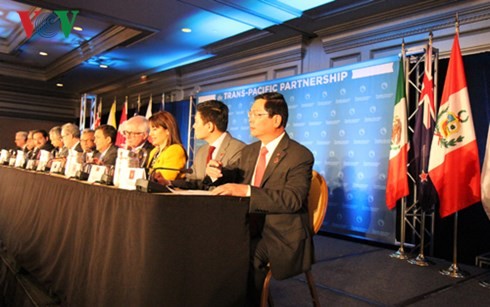(VOVworld) – On October 5, after 5 years of negotiation, the 12 members of the Trans-Pacific Partnership (TPP) reached a final consensus on the world’s largest free trade agreement. The historic agreement will be a cooperative model for the 21st century, opening up a prosperous future for its signatories, including Vietnam.
 |
Vietnamese Trade Minister Vu Huy Hoang and other 11 Trade Ministers at a press conference to announce the conclusion of TPP negotiation in Atlanta, on Oct 5, 2015
|
The TPP is a free trade agreement involving 12 Asia-Pacific states: Australia, Brunei, Canada, Chile, Japan, Malaysia, Mexico, New Zealand, Peru, Singapore, the US, and Vietnam. The TPP is more comprehensive and covers more areas than other free trade agreements. It targets the establishment of high-standard trade regulations in resolving global economic issues in the 21st century and promoting exclusive growth and employment. Besides economics, the TPP covers other areas, including the environment and intellectual property rights.
Generating positive pressure for Vietnam’s resilient growth
The TPP is second in scale to the WTO. But the TPP focuses more on tax reduction, taking into consideration development gaps between members. Vietnam will benefit greatly from the TPP, which represents about 40 percent of the global gross domestic product (GDP) and 30% of the global export and import revenue. Minister of Industry and Trade Vu Huy Hoang says: “Vietnam’s exports will benefit the most, particularly our staples including garments and textiles, footwear, and aquaculture products. When the TPP takes effect, Vietnam expects to post two-digit export growth annually and the GDP will maintain its steady growth rate.”
Vietnam will have more opportunities to attract foreign direct investment and high-technology projects, and benefit from technology transfer between TPP members. Businesses from other TPP countries will increase their investment in Vietnam, a manufacturer of spare parts and devices for domestic sales and export.
As a TPP member, Vietnam can diversify its trade and investment relations and avoid dependence on particular countries.
The TPP will generate jobs, particularly in the countryside and in sectors needing a large number of employees such as textiles, clothing, footwear, and agro-fishery products.
Challenges
Joining a large bloc like the TPP will force Vietnam to improve its competitiveness and narrow its development gap with other countries. The husbandry and service sectors will face difficulties, but the experience Vietnam gas gained from WTO membership should help.
Smaller enterprises will need appropriate strategies to survive in the new environment. Minister Vu Huy Hoang has suggested ways to minimize the anticipated difficulties. “First, we have to continue our economic restructuring and growth model reform. We have to promote our spearhead sectors and persuade other TPP states to help us improve our poor sectors. We must take drastic steps to fine tune the legal framework in trade, investment, and enterprises.”
Now that the TPP negotiation has concluded, countries will match the Agreement’s provisions to their national laws. The deal must be officially signed by all the Trade Ministers and approved by the legislature of each nation before taking effect.